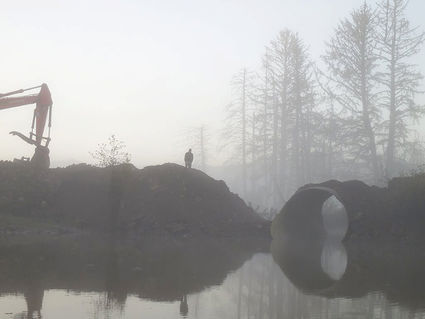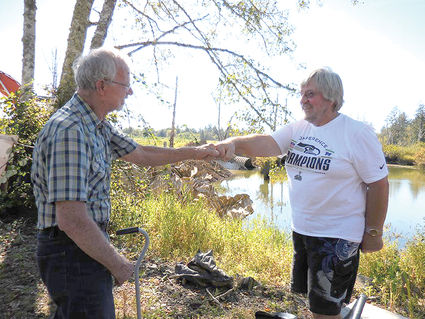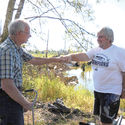Troublesome culverts removed from dike
September 25, 2014

Courtesy of Poul Toftemark
Culverts removed A contractor this week finished removing two 13-foot culverts from a dike at the end of Kandoll Road. The Columbia Land Trust installed the culverts about eight years ago as part of a wetland restoration project, but the project caused flooding of nearby property, and the increased current from the culverts has been eroding dikes along Seal Slough. The land trust has created new wetland channels and installed tide gate as part of the plan to address the problems.
When Poul Toftemark moved to Rosburg in 1995, he had no idea he would eventually spend more than eight years in battle with Columbia Land Trust over a pair of culverts on their Kandoll Farm project.
The Grays River Habitat Enhancement District maintained that the culverts contributed to the erosion of the dike and the piece of mind of the people who lived along the Seal Slough, but Columbia Land Trust did not agree.
The battle ended this weekend, when the Columbia Land Trust removed the culverts.
Toftemark was elated.
"The two 13 foot culverts have been the biggest problem in this project," Toftemark said. "This used to be a tide gate which would not allow water to come in but would allow water to go out, thus making this a farm for cattle and haying. Columbia Land Trust wanted to restore the acreage to wetlands in order to become salmon rearing habitat, which is all fine and dandy, but by doing it the way they did, they created a flow problem."
The water came up Seal Slough with the tide and filled in the wetlands. However, when the tide went out, it went out too fast and had begun to erode out the dikes which had been built by dragline, according to Toftemark, when a big crane scooped up the mud into a pile.
"There is nothing strong holding the dike," he said. "It's basically silt. That is why we fought this thing. If I hadn't I would be sitting on three quarters of an acre of land and the rest of my eight acres would be swamp."
It was the results of a study, a study that Toftemark requested and Columbia Land Trust agreed to that finally caught their attention.
"The lower rebar in the dike had moved two feet laterally and half a foot downward in two years according to the study," Toftemark said. "The bank had migrated laterally four to five feet from 2009 to 2013."
The study concluded the shift was due to the culverts and brought about their removal this weekend.

Courtesy of Poul Toftemark
Grays River Habitat Enhancement District Commissioners Delvin Fredrickson, left, and Poul Toftemark exchange a fist bump to celebrate the removal of troublesome culverts.
Toftemark worked with his neighbors and co-chairs for the Grays River Habitat Enhancement District, Delvin Frederickson and Al George. George resigned and health issues kept Frederickson from seeing it through, though he did meet with Toftemark to celebrate over the weekend.
According to Toftemark, Columbia Land Trust has promised to find ways to stabilize the dike along Seal Slough, which has been badly damaged.
"I really did not think it would happen but I was not going to give up trying," Toftemark said. "I've had a number of people commend me for sticking with it. It's a David and Goliath thing. It can be done. And through all of this, communication with the community of developments has been improved a lot."
Ian Sinks of Columbia Land Trust echoed some of those sentiments.
"We needed to balance community concerns with the restoration," Sinks said. "We're happy to be here and happy to have this partnership."
"We want to be good stewards of the land as well as good neighbors," he finished.












Reader Comments(0)